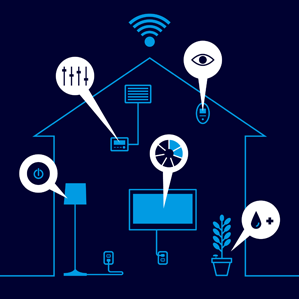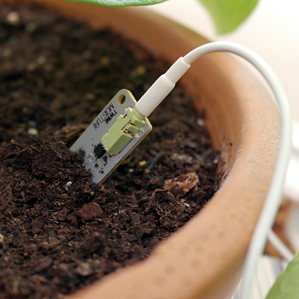Home Tweet Home: A House with Its Own Voice on Twitter
At first glance, you’d never guess there’s anything unusual about Tom Coates’s San Francisco home. Nestled at the end of a narrow passageway on a side street, it’s a peaceful, sunny house decorated with modern furniture and bright posters that say things like “Machines help us work” and “Make your own path.”

But take a closer look at, say, the ficus tree in the corner of the living room and you’ll notice something odd: a sensor, sticking out of the dirt, that’s connected to a little box. The sensor monitors the plant’s moisture, and the box transmits readings wirelessly to the Internet; it is just one of numerous Internet-connected devices in Coates’s home, which help keep an eye on everything from how warm it is to whether someone is currently in the living room.
Coates has programmed these sensor data to run the house’s very own Twitter feed. The house tweets things like “I just turned on the downstairs lights. It was getting a bit dark.” Or it might tweet “Someone just activated the Sitting Room Sensor so I’m pretty sure someone’s at home.”

As weird as a Twitter-enabled house might seem, it offers a glimpse of the future. As interest grows in the “Internet of things”—the idea of adding network connectivity to all sorts of normal objects—everything from desk lamps to ovens may soon come Internet-ready.
Coates, who’s also cofounder of a stealth-mode Internet-of-things startup called Product Club, says that for a long time, the Web was like a brain in a tank, in that it couldn’t interface with the real world. But the arrival of Internet-enabled products like the Lockitron door lock and the Nest thermostat, as well as devices like Twine and WeMo, which can add Internet connectivity to otherwise dumb devices, is starting to change this. “It feels like the last few years is about letting that brain in the tank kind of see the outside world and respond to it, and activate and move things and change things in the real world,” he says.
Adding network connectivity to appliances can make them smarter and more convenient to use (see “How Nest’s Control Freaks Reinvented the Thermostat”). But it can also present new problems in terms of reliability and security.

Coates used a few inexpensive, off-the-shelf devices to let his home interact with the real world—on Twitter at least. Several Belkin WeMo switches allow him to control the lights in his living room, office, and bedroom from his iPhone; a WeMo motion sensor can tell if anyone enters the room; and a Twine device tracks the temperature and the ficus tree’s moisture level. Coates relies heavily on a simple, free Web tool called IFTTT (“If This Then That”), which allows users to set automated online actions in response to specific triggers—such as sending an e-mail when a particular person uploads a new Instagram photo. IFTTT is used to turn the light on in Coates’s home office at sunset, and tweet about various goings-on.
Sometimes other Twitter users will try to engage the house in conversations, in which case Coates may step in as the “voice” of the house to have a little fun (such as telling a spammer that no, the house does not need any Viagra). “It’s almost like the house has become a sort of pet I look after, and it expresses that being-looked-after-ness back to me,” he says. “It’s like a Tamagotchi or something.”
Although his Foursquare check-ins pop up in the Twitter feed with a message that says “Looks like Tom’s gone out,” Coates is not concerned about broadcasting so much information—he notes that the WeMo motion detector would sense an intruder and post about it on Twitter; he could then ask his neighbors to check it out.
Coates’s startup, Product Club, is exploring the interplay between physical objects and the Internet by prototyping a number of projects, including network-enabled home devices. Cofounder Matt Biddulph is building a cell phone to help Product Club’s explorations. He’s using parts purchased over the Web and playing around with different networking technologies, including low-power Bluetooth, Wi-Fi, and ZigBee.
Eventually, Coates says, Internet connectivity will work its way into all kinds of household appliances, especially “boring” ones like dishwashers and washing machines, allowing them to notify you on your smartphone when they’re done doing their job.
“When the dishwasher or the washing machine are running, I want them to tell me when they’re finished or how long there is to go,” he says. “I want that kind of information, because it’s just irritating not knowing.”
Keep Reading
Most Popular
Large language models can do jaw-dropping things. But nobody knows exactly why.
And that's a problem. Figuring it out is one of the biggest scientific puzzles of our time and a crucial step towards controlling more powerful future models.
The problem with plug-in hybrids? Their drivers.
Plug-in hybrids are often sold as a transition to EVs, but new data from Europe shows we’re still underestimating the emissions they produce.
How scientists traced a mysterious covid case back to six toilets
When wastewater surveillance turns into a hunt for a single infected individual, the ethics get tricky.
Google DeepMind’s new generative model makes Super Mario–like games from scratch
Genie learns how to control games by watching hours and hours of video. It could help train next-gen robots too.
Stay connected
Get the latest updates from
MIT Technology Review
Discover special offers, top stories, upcoming events, and more.